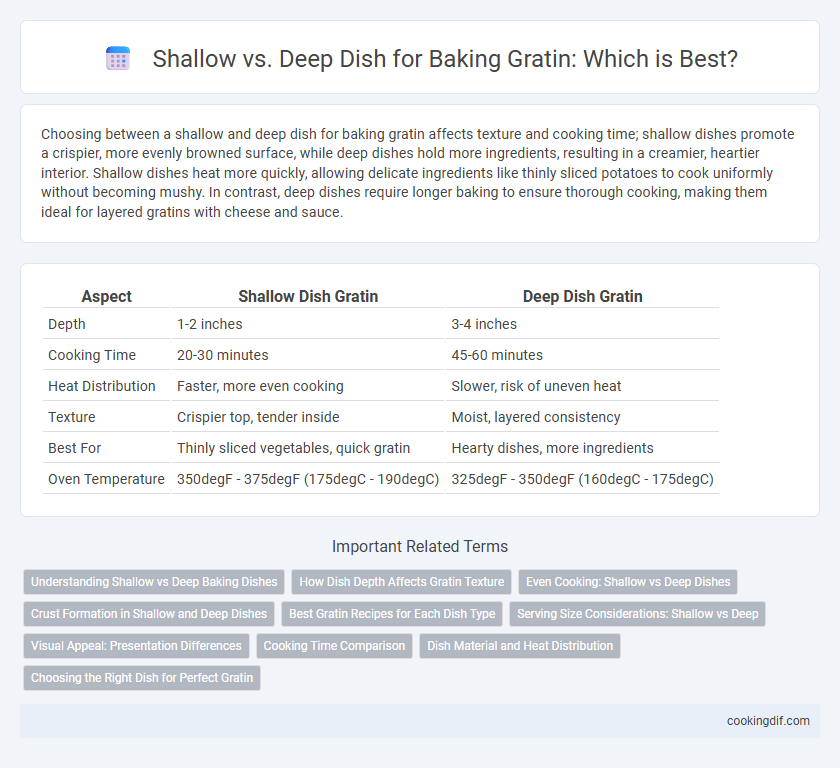Choosing between a shallow and deep dish for baking gratin affects texture and cooking time; shallow dishes promote a crispier, more evenly browned surface, while deep dishes hold more ingredients, resulting in a creamier, heartier interior. Shallow dishes heat more quickly, allowing delicate ingredients like thinly sliced potatoes to cook uniformly without becoming mushy. In contrast, deep dishes require longer baking to ensure thorough cooking, making them ideal for layered gratins with cheese and sauce.
Table of Comparison
| Aspect | Shallow Dish Gratin | Deep Dish Gratin |
|---|---|---|
| Depth | 1-2 inches | 3-4 inches |
| Cooking Time | 20-30 minutes | 45-60 minutes |
| Heat Distribution | Faster, more even cooking | Slower, risk of uneven heat |
| Texture | Crispier top, tender inside | Moist, layered consistency |
| Best For | Thinly sliced vegetables, quick gratin | Hearty dishes, more ingredients |
| Oven Temperature | 350degF - 375degF (175degC - 190degC) | 325degF - 350degF (160degC - 175degC) |
Understanding Shallow vs Deep Baking Dishes
Shallow baking dishes, typically 1 to 2 inches deep, allow gratins to cook quickly and develop a crisp, golden crust due to better heat penetration and moisture evaporation. Deep baking dishes, ranging from 2.5 to 4 inches in depth, retain more moisture, resulting in a creamier interior but requiring longer baking times for even cooking. Choosing the right dish depth affects texture and cooking time, with shallow dishes ideal for thinner layers and deep dishes best suited for hearty, layered gratins.
How Dish Depth Affects Gratin Texture
Shallow dishes promote faster moisture evaporation, resulting in a crispier, golden-brown crust on gratins. Deep dishes retain more steam, creating a creamier, softer interior with a less pronounced crust. The choice of dish depth thus directly influences the balance between a crunchy topping and a tender, moist filling in gratin recipes.
Even Cooking: Shallow vs Deep Dishes
Shallow dishes promote more even cooking in gratins by allowing heat to penetrate quickly and uniformly, preventing soggy layers and ensuring a crisp top. Deep dishes can trap moisture, resulting in longer cooking times and a less consistent texture, often requiring adjustments in temperature and baking duration. Choosing a shallow dish optimizes browning and maintains the signature creamy layers of a perfect gratin.
Crust Formation in Shallow and Deep Dishes
Shallow dishes promote faster crust formation in gratins due to increased surface area exposure and higher heat penetration, resulting in a crispier, more evenly browned crust. Deep dishes tend to produce a thicker, softer crust as the heat distributes more gradually and moisture is retained longer within the ingredients. Optimal crust texture relies on selecting the right dish depth to balance browning and moisture retention during baking.
Best Gratin Recipes for Each Dish Type
Shallow dishes promote even browning and a crispier cheese crust, making them ideal for classic potato gratins where thin, tender layers cook uniformly. Deep dishes accommodate thicker layers and creamier textures, perfect for vegetable or mixed-grain gratins requiring longer baking to meld flavors thoroughly. Selecting the proper dish depth enhances texture contrast and flavor infusion, tailored to the specific gratin recipe's ingredients and desired outcome.
Serving Size Considerations: Shallow vs Deep
Shallow gratin dishes typically hold smaller portions, ideal for individual or small servings, while deep dishes accommodate larger quantities suitable for family-style meals or gatherings. The depth influences cooking time and texture, with deeper dishes requiring longer baking to ensure even heating throughout. Choosing between shallow and deep gratin pans depends on serving size needs and desired presentation.
Visual Appeal: Presentation Differences
Shallow gratin dishes create a crispier, evenly browned top layer with visible texture, enhancing visual appeal through golden edges and bubbling cheese. Deep dish gratins produce thicker, layered presentations where ingredients meld, offering a hearty, rustic look but less surface crispness. Choosing between shallow and deep dishes impacts the gratin's final appearance, balancing aesthetic elegance with substantial, layered richness.
Cooking Time Comparison
Shallow gratin dishes cook faster due to their increased surface area, allowing heat to penetrate more evenly and reducing overall baking time to about 25-30 minutes. Deep dishes require longer cooking times, often between 40-50 minutes, as heat takes more time to reach the center, ensuring ingredients cook thoroughly. Choosing between shallow and deep gratin dishes impacts not only texture but also the precision needed in cooking time management.
Dish Material and Heat Distribution
Shallow dishes, often made of ceramic or glass, provide faster and more even heat distribution ideal for achieving a crispier gratin top. Deep dishes, typically heavier cast iron or stoneware, retain heat longer, allowing slower cooking that enhances the layering of flavors and textures. Material thickness and heat conductivity significantly influence the gratin's browning and moisture retention during baking.
Choosing the Right Dish for Perfect Gratin
Shallow dishes promote even browning and crispy tops in gratins by allowing heat to penetrate quickly and moisture to evaporate efficiently. Deep dishes retain more moisture, resulting in a creamier texture but may require longer baking times to ensure the center is fully cooked. Selecting the right dish depends on desired texture: opt for shallow gratin pans for a golden crust or deep casserole dishes for rich, tender layers.
Shallow vs Deep dish for baking Infographic

 cookingdif.com
cookingdif.com